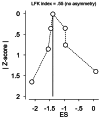Efficacy of transcranial direct current stimulation on seizure control in patients with refractory epilepsy: a systematic review and meta-analysis of randomized controlled trials
- PMID: 40533536
- PMCID: PMC12177013
- DOI: 10.1007/s10143-025-03657-0
Efficacy of transcranial direct current stimulation on seizure control in patients with refractory epilepsy: a systematic review and meta-analysis of randomized controlled trials
Abstract
Drug-resistant epilepsy is a challenging condition that affects around 30% of all patients with epilepsy. Evidence regarding treatment options is limited, especially for surgery and invasive techniques. However, non-invasive techniques constitute a promising alternative for these patients. This meta-analysis aims to evaluate the effectiveness of transcranial direct current stimulation on seizure frequency management in patients with drug-resistant epilepsy. We searched the literature in PubMed, Scopus, and Web of Science up to December 2023. We included randomized controlled trials that compared transcranial direct current stimulation with sham stimulation. Our main outcomes of interest were a percentage reduction in seizure frequency and epileptiform discharge frequency. A total of 10 studies with 269 patients were included. Monthly seizure frequency was significantly reduced by an average of -45.39%and -39.34% at week 4 and week 8, respectively. There was a significant reduction in IED in favor of tDCS at week 2 (SMD = -0.87, 95% CI = [- 1.49, - 0.25], P = 0.006), 4 weeks (SMD = -1.17, 95% CI = [- 1.67, - 0.66], P < 0.00001, Moderate quality of evidence) and 8 weeks (SMD = -1.11, 95% CI = [- 1.69, - 0.53], P = 0.0002) of follow-up. There were no serious adverse events associated with the stimulation. Transcranial direct current stimulation was associated with a reduction in both seizure frequency and epileptiform discharges with minimal side effects. Further studies with larger sample sizes and consensus protocol guidelines are needed to verify its long-term safety and effectiveness.
Keywords: Drug-resistant epilepsy; Non-invasive neurostimulation; Seizure frequency; Transcranial direct current stimulation; tDCS.
© 2025. The Author(s).
Conflict of interest statement
Declarations. Ethical approval: This article is based on previously conducted studies and does not contain any current intervention with human participants. Consent to participate: Not applicable. Consent for publication: Not applicable. Competing interests: The authors declare no competing interests.
Figures









Similar articles
-
Non-invasive brain stimulation techniques for chronic pain.Cochrane Database Syst Rev. 2018 Mar 16;3(3):CD008208. doi: 10.1002/14651858.CD008208.pub4. Cochrane Database Syst Rev. 2018. Update in: Cochrane Database Syst Rev. 2018 Apr 13;4:CD008208. doi: 10.1002/14651858.CD008208.pub5. PMID: 29547226 Free PMC article. Updated.
-
Yoga for epilepsy.Cochrane Database Syst Rev. 2017 Oct 5;10(10):CD001524. doi: 10.1002/14651858.CD001524.pub3. Cochrane Database Syst Rev. 2017. PMID: 28982217 Free PMC article.
-
Non-invasive brain stimulation techniques for chronic pain.Cochrane Database Syst Rev. 2018 Apr 13;4(4):CD008208. doi: 10.1002/14651858.CD008208.pub5. Cochrane Database Syst Rev. 2018. PMID: 29652088 Free PMC article.
-
Treatments for seizures in catamenial (menstrual-related) epilepsy.Cochrane Database Syst Rev. 2021 Sep 16;9(9):CD013225. doi: 10.1002/14651858.CD013225.pub3. Cochrane Database Syst Rev. 2021. PMID: 34528245 Free PMC article.
-
Pregabalin add-on for drug-resistant focal epilepsy.Cochrane Database Syst Rev. 2022 Mar 29;3(3):CD005612. doi: 10.1002/14651858.CD005612.pub5. Cochrane Database Syst Rev. 2022. PMID: 35349176 Free PMC article.
References
-
- Kwan P, Arzimanoglou A, Berg AT et al (2010) Definition of drug resistant epilepsy: consensus proposal by the ad hoc task force of the ILAE commission on therapeutic strategies. Epilepsia 51:1069–1077 - PubMed
-
- Baud MO, Perneger T, Rácz A et al (2018) European trends in epilepsy surgery. Neurology 91:e96–e106 - PubMed
-
- Barba C, Giometto S, Lucenteforte E et al (2022) Seizure outcome of Temporal lobe epilepsy surgery in adults and children: A systematic review and Meta-Analysis. Neurosurgery 91:676–683 - PubMed
-
- San-Juan D (2021) Cathodal transcranial direct current stimulation in refractory epilepsy: A noninvasive neuromodulation therapy. J Clin Neurophysiol 38:503–508 - PubMed
Publication types
MeSH terms
LinkOut - more resources
Full Text Sources
Medical

